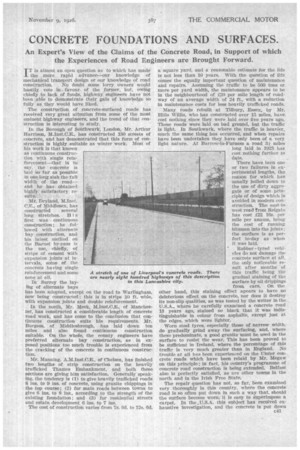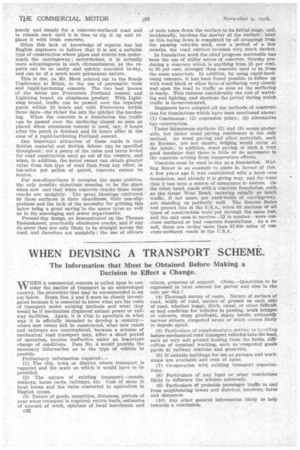CONCRETE FOUNDATIONS AND SURFACES.
Page 123

Page 124

If you've noticed an error in this article please click here to report it so we can fix it.
An Expert's View of the Claims of the Concrete Road, in Support of which the Experiences of Road Engineers are• Brought Forward.
IT is almost an open question as to which has made the more rapid advance—our knowledge of mechanical transport design or our knowledge of road
construction. No doubt some lorry owners would hastily vote in favour. of the former, but, owing chiefly to lack of funds, highway engineers have not been able to demonstrate their gain of knowledge so fully as they would have liked.
The construction of concrete-surfaced roads has received very great attention from some of the most eminent highway engineers, and the trend of that construction is interesting to study.
In the Borough of Southwark, London, Mr. Arthur Harrison, M.Inst.C.E., has constructed 130 streets of concrete, and has demonstrated that this form of construction is highly suitable as winter work. Most of his work is that known as continuous construetion with single reinforcement—that is to
say,concrete is laid o far as possible in one long slab the-full width• of the road— and he has obtained highly Satisfactory results.
Mr. Dryland, M.Inst. C.E., of Middlesex, has construefed several long stretches. H i s first was continuous construction; he followed with alternate bay construction, and his latest method on the Barnet by-pass is the use, chiefly, of strips of cement with expansion joints at intervals, sonae of the concrete having single reinforcement and some none at all.
In Surrey the laying of alternate bays has been adopted, except on the road to Warlingham, now being constructed; this is in strips 10 ft. wide, with expansion joints and double reinforcement.
In the north, Mr. Meek, Minst.C.E., of Manchester, has constructed a considerable length of concrete road work, and has come to the conclusion that continuous construction suits his requirements. Mr. Burgess, of Middlesbrough, has laid down ten miles and also found continuous construction suitable. On the whole, the connty engineers have preferred alternate bay construction, as in exposed positions too much trouble is experienced from the cracking of the concrete in continuous construction.
Mr. Manning, A.M.Inst.C.E., of Chelsea, has finished two lengths of strip construction on the heavily trafficked Thames Embankment, and both these sections are giving him satisfaction. Generally speaking, the tendency is (1) to give heavily trafficked roads 8 ins. to 9 ins, of concrete, using granite chippings in the top course; (2) for main roads between towns to give 6 ins. to 8 ins., according to the strength of the existing foundation; and (3) for residential streets and estate development 6 ins. te 7 ins. The cost of construction varies from 7s. 6d. to 12s. 6d. a square yard, and a reasonable estimate for the life is not less than 10 years. With the question of life comes the equally important question of maintenance and repairs. Assuming the traffic to be 500 tons or more per yard width, the maintenance appears to be in the neighbourhood of £20 per mile length of roadway of an average width of 24 ft, with a reduction in maintenance costs for less heavily trafficked roads.
Many roads rebuilt at Tilbury, Essex, by Mr. Hills Willis, who has constructed over 15 miles, have cost nothing since they were laid over five years ago. These roads were laid, on bad ground, but the traffic is light. In Southwark, where the traffic is heavier, much the same thing has occurred, and when repairs have been undertaken they have only been of a, very light nature. At Barrow-in-Furness a road 31 miles long laid in 1923 has cost nothing further to date.
There have been one or two failures in experimental lengths, the reason for which has usually boiled down to the use of dirty aggregate or of some principle of design which is avoided in modern construction. The east-to west road from Reigate has cost 122 16s. per mile per annum, being the cost of running bitumen into the joints the surface is as perfect to-day as when it was laid.
Rubber tyred vehicles do not damage the concrete surface at all, the only noticeable result after months 'of . this traffic being the gradual staining of the surface by oil drippings from, cars. On the other hand, this staining effect apears to have no deleterious effect on the concrete, nor does it destroy its non-slip qualities, as was tested by the writer in the U.S.A., where he carefully examined a concrete road 13 years ago, stained so black that it was indistinguishable in colour from asphalte, except just at the edges, which were lighter. Worn steel tyres, especially those of narrow width, do gradually grind away the surfacing, and, where these predominate, a good granite must be used in the surface to resist the wear. This has been proved to be sufficient in Ireland, where the percentage of this traffic is very much greater than in England. No trouble at all has been experienced on the Ulster concrete roads which have been relaid by Mr. Megaw on this principle ; in fact, his country's programme of concrete road construction is being extended. Belfast also is perfectly satisfied, as are other towns in the north and in the Irish Free State.
The repair question has not, so far, been examined very thoroughly in this country, where the concrete road is so often put down in such a way that, should the surface become worn, it is easy to Superimpose a carpet. In the .U.S.A. this subject has received exhaustive investigation, and the concrete is put down purely and simply for a concrete-surfaced road and to remain such until it is time to rip it up and replace it with fresh concrete.
Often this lack of knowledge of repairs has led English engineers to believe that it is not a suitable type of construction where pipes and sewers run underneath the carriageway ; nevertheless, it is actually more advantageous in such circumstances, as the repairs can be so easily and quickly executed to-day, and can be of a much more permanent nature.
This is due, as Mr. Meek pointed out to the Roads Conference at Milan, to the use of pneumatic tools and rapid-hardening cements. The two best known of the latter are Ferrocrete Portland cement and Lightning brand, an aluminous product. With Lightning brand, traffic can be passed over the repaired patch within 24 hours and with Ferrocrete within three days—the richer the mix the quicker the hardening. When the concrete is a foundation the traffic can be passed over the surfacing almost so soon as placed when altiminous cement is used, say, 8 hours after the patch is finished and 24 hours after in the case of a rapid-hardening Portland cement.
One important attraction of these roads is that British material and British labour can be specified throughout ; not a penny of the rates and taxes levied for road construction need go out of the country, and when, in addition, the motor owner can obtain greater value from this type of road than from any other, in ton-miles per gallon of petrol, concrete cannot be beaten.
For non-slipperiness it occupies the same position, the only possible objections seeming to be the glare when new and that when concrete cracks these same cracks are unsightly. The great blessings conferred by these surfaces is their cleanliness, their non-slipperiness and the lack of the necessity for gritting, this latter being a great saving–to the motor tyres as well as to the scavenging and sewer departments.
Present-day design, as demonstrated on the Thames Embankment, practically eliminates cracks, and if any do occur they are only likely to be straight across the road, and therefore not unsightly; the use of silicate of soda tones down the surface in its initial stage, and, incidentally, hardens the mortar at the surface ; later on this toning down is completed by oil droppings from the passing vehicles until, over a period of a few months, the road surface becomes very much darker.
In foundation work the chief progress noticeable has been the use of stiffer mixes of concrete, thereby producing a concrete which is anything from 25 per cent. to 50 per cent, stronger than concrete used to be from the same materials. In addition, by using rapid-hardening cements, it has been found possible to follow up with wood block or other form of surfacing very closely and open the road to traffic so soon as the surfacing is ready. This reduces considerably the cost of watching and lighting, and shortens the period during which traffic is inconvenienced.
Engineers have adopted all tile methods of construction for foundations which have been mentioned above: (1) Continuous; (2) expansion joints ; (3) alternative hay construction.
Under bituminous surfaces (2) and (3) seems preferable, but under wood paving continuous is the only method. As wood paving and other materials, such as Roctnac, are not elastic. bulging would occur at the joints; in addition, wood paving is such a very good insulator that there is little or no movement in the concrete arising from temperature effects.
Concrete must be used to-day as a foundation. Watling Street is an example to quote in favour of this. A few years ago it was constructed with a hard core foundation, and already it is giving way, and for some time it has been a source of annoyance to motors. On the other hand, roads with a concrete foundation, such as the Great West Road, carrying equally as much traffic, if not more, per yard-width of carriageway, are standing up perfectly well. The famous Bates test proved this in the U.S:A., when 63 sections of all types of construction were put through the same test, and the only ones to survive-13 in number—were concrete surfaced or had concrete foundations. As a result, there are to-day more than 37,000 miles of concrete-surfaced roads in the -U.S.A.












































































































































































































